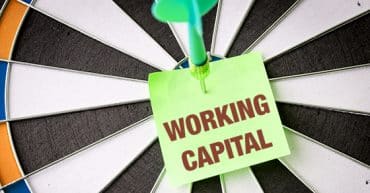Working capital and cash flow are two variables that finance teams need to understand to determine if their companies can endure an unforeseen downturn or crisis. These two indicators show various facets of a business’s financial health. Working capital is the difference between a company’s current assets, such as cash, and other assets that can be converted into cash within a year, and its current liabilities. To help you understand more about working capital ratio, loans, management, and so much more this post was designed for such
What is working capital?
Working capital, (WC), also known as “networking capital” (NWC), is the difference between a company’s current assets (cash, accounts receivable/unpaid bills, raw materials, and finished goods inventories) and current liabilities (debts and accounts payable).
Working capital is a metric that measures a business’s liquidity, operational efficiency, and short-term financial health. If a company has a significant amount of positivity, it should be able to invest and grow. If a company’s present assets do not equal its current liabilities. It may struggle to grow or repay creditors, and may even go bankrupt.
Overview
These estimates are derived from the array of assets and liabilities on a corporate balance sheet.
Cash, accounts receivable, inventory, and other assets that are to be liquidated or converted into cash in less than a year are described as current assets. Accounts payable, wages, and taxes payable. Also, the current portion of long-term debt due within one year is an example of current liabilities.
To determine working capital, divide the former by the latter, or subtract one from the other. Working capital is calculated by subtracting current assets from current liabilities. If a company’s current assets to liabilities ratio is less than one, it has a negative.
A corporation with positive working capital can fund present operations while also investing in future activities and growth.
Working capital that is comparable to or higher than the industry average for a company of a similar size is generally seen as appropriate. Low operating capital could signal a risk of bankruptcy or default.
Objectives of working capital
This is an important indicator for organizations to monitor because it indicates the amount of cash on hand to make payments. Cover unexpected costs, and keep operations running smoothly. Working capital management, on the other hand, isn’t so straightforward. Thus, a working capital management program might have a variety of goals, including:
#1. Meeting obligations
Working capital management should always guarantee that the company has enough liquidity to satisfy its short-term obligations. This can be accomplished by collecting payments from consumers sooner or extending payment terms for suppliers. Unexpected costs can be regarded as obligations. Thus they must be in the management strategy as well.
#2. Growing the business
That said, it’s equally critical to make good use of your short-term assets. Whether it’s by supporting worldwide expansion or investing in R&D. Your business may not be as profitable as it may be if your assets are up in inventory or accounts payable. To put it another way, a conservative approach to management is ineffective.
#3. Optimizing capital performance
Another goal of management is to improve capital utilization efficiency. whether by lowering capital expenses or increasing capital returns. The former can be by reclaiming cash that is now in order to reduce the need for borrowing. While the latter entails ensuring that the return on spare capital outweighs the cost of financing it.
Components of Working Capital
#1. Current Assets
This is the value of a company’s current assets (both tangible and intangible) that it can readily convert to cash in one year or one business cycle, whichever comes first. Checking and savings accounts; highly liquid marketable securities such as stocks, bonds, mutual funds, and exchange-traded funds (ETFs); money market accounts; cash and cash equivalents, accounts receivable, inventory, and other shorter-term prepaid expenses are all examples of current assets.
Current assets from terminated activities and interest payable are two further instances. Remember that current assets are assets that can be converted into cash rapidly and do not include long-term or illiquid investments like hedge funds, real estate, or collectibles.
#2. Current Liabilities
Current liabilities, on the other hand, are all the debts and expenses that the company expects to pay off within a year or one business cycle, whichever comes first. Rent, utilities, materials, and supplies; interest or principal payments on debt; accounts payable; accumulated liabilities; and accrued income taxes are often in this category.
This category includes dividends due, capital leases due within a year, and long-term debt that is presently due.
Why Is Working Capital Important?
Working capital is critical since it is for firms to stay afloat. Even if a company is profitable, it can become bankrupt in theory. After all, a company can’t rely on paper earnings to pay its payments; those bills must be paid with cash on hand. Assume a corporation has $1 million in cash due to retained earnings from past years. If the corporation invests the entire $1 million at once. It may not have enough current assets to cover its current liabilities.
Working capital management
Working capital management’s major goal is to ensure that the company has enough cash flow to pay its short-term operating costs and debt obligations. The difference between a company’s current assets and current liabilities is its WC.
Anything that can be quickly changed into cash within a year is considered a current asset. These are the company’s assets that are extremely liquid. Cash, accounts receivable, inventory, and short-term investments are examples of current assets. Any commitments due within the next 12 months are current liabilities. Accruals for operating expenses and current components of long-term debt payments are examples of this.
Working capital management often entails analyzing important parts of WC. Such as the working capital ratio, collection ratio, and inventory turnover ratio, to track cash flow, current assets, and current liabilities.
Working capital management aids in the smooth operation of the net operating cycle. Also known as the cash conversion cycle (CCC) the time it takes to convert net current assets and liabilities into cash in the shortest possible period.
WC management can help a company’s cash flow management and earnings quality by ensuring that its resources are efficient.
Working Capital Ratios
The working capital ratio, also known as the current ratio, the collection ratio, and the inventory turnover ratio is three significant ratios in working capital management.
#1. Current Ratio (Working Capital Ratio)
The current ratio, also known as the working capital ratio, is dividing current assets by current liabilities. It’s an important indicator of a company’s financial health since it shows how well it can satisfy short-term financial obligations.
A working capital ratio of less than 1.0 often implies that a company is having problems meeting its short-term obligations, though the numbers vary by industry. That is, the company’s debts due in the future year would be insufficient to cover them. In this instance, the corporation may have to sell assets, and secure long-term loans. Or seek other forms of funding to meet its short-term debt obligations.
Working capital ratios of 1.2 to 2.0 are generally good, but a ratio greater than 2.0 may indicate that the company is not properly utilizing its assets to grow revenues. A high ratio could suggest that the company is not effectively managing its WC.
#2. Collection Ratio (Days Sales Outstanding)
The collection ratio, is commonly known as days sales outstanding (DSO). This is a measure of a company’s ability to manage its accounts receivables effectively. The collection ratio is multiplying the number of days in an accounting period by the average amount of outstanding accounts receivables and dividing it by the total amount of net credit sales during that period.
The average number of days it takes a corporation to receive payment following a credit sales transaction is by the collection ratio calculation. The collection ratio will be lower if a company’s billing department is effective in collections attempts and customers pay their bills on time. The faster a corporation converts receivables into cash, the lower its collection ratio.
#3. Inventory Turnover Ratio
Inventory management is the final component of working capital management. A corporation must retain enough inventory on hand to meet customer needs. While avoiding excessive inventory that ties up WC in order to operate at optimal efficiency and maintain a comfortable high level of WC.
The inventory turnover ratio is commonly used by businesses to determine how efficient that balance is. The inventory turnover ratio, which is computed by dividing the cost of goods sold by the average balance sheet inventory, shows how quickly a company’s inventory is utilized and replaced. A low ratio compared to industry peers implies a risk of too high inventory levels, whilst a high ratio indicates insufficient inventory levels.
What are the 4 Main Components of Working Capital?
Inventories, accounts receivable, accounts payable, and cash is the components that make up a company’s working capital. A well-managed company will manage its short-term debt as well as its present and future operational expenses through the management of its working capital.
What Affects Working Capital?
The drop in working capital could be the consequence of a number of different events, including a fall in sales revenues, improper management of inventories, or issues with accounts receivable. These are just some of the potential causes.
What are the Main Sources of Working Capital?
- Sources of working capital
Long-term loans, a provision for depreciation, retained earnings, debentures, and share capital are all examples of potential sources of long-term working capital. The receipt of dividends or tax provisions, cash credit, public deposits, and other options are examples of sources of short-term working capital.
What is Negative Working Capital?
Working capital that is negative is inextricably linked to a company’s current ratio, which may be determined by dividing the company’s current assets by the company’s current liabilities. When the current ratio is less than 1, it indicates that the current obligations are greater than the current assets, which results in negative working capital.
Working capital loan
When a company does not have enough cash on hand or asset liquidity to cover day-to-day operational needs. It may need to take out a loan. Working capital loans may be used by businesses with high seasonality or cyclical sales to assist them to get through periods of low business activity.
Many businesses do not have consistent or predictable revenue year after year. Manufacturing firms, for example, may experience cyclical sales that correlate to store demands. During the fourth quarter that is, during the holiday season most shops sell more stuff than at any other time of the year.
Manufacturers normally conduct the majority of their production activity throughout the summer months. Preparing stockpiles for the fourth-quarter push, in order to supply shops with the right amount of goods. Then, as the end of the year approaches, merchants reduce manufacturing purchases in order to sell off their inventory. Resulting in lower manufacturing sales.
Manufacturers with this kind of seasonality frequently need a working capital loan to cover wages and other operating expenses during the fourth quarter’s down season. The loan is usually the time the business reaches its peak season and no longer needs it.
Pros and Cons of Working Capital Loans
A working capital loan has the immediate benefit of being simple to secure and allowing business owners to swiftly plug any shortfalls in WC costs. The fact that it is a kind of debt financing rather than an equity transaction means that a business owner retains full control of their company, even if the need for financing is urgent.
Unsecured working capital loans are available. A corporation is not to put up any collateral to secure the loan if this is the case. Unsecured loans are only available to firms or business owners with excellent credit. Businesses with poor credit must securitize their loans.
Asset collateral is for a collateralized working capital loan, which can be a disadvantage in the financing procedure. However, there are several disadvantages to taking out a loan. To compensate the lending institution for risk, interest rates are set high. Furthermore, working capital loans are frequently tied to a business owner’s personal credit, and any missed payments or defaults may have a negative impact on their credit score.
What is a Good Current Ratio?
A current ratio that is between 1.2 and 2 is considered to be healthy for an organization. This indicates that the company has 2 times more current assets than current liabilities to cover its debts. If a corporation has a current ratio that is lower than 1, it indicates that it does not have sufficient liquid assets to satisfy its short-term commitments.
Why is Low Working Capital Good?
If a firm is able to keep its working capital at a low level without taking on an excessive amount of liquidity risk, then this level is helpful to both the day-to-day operations of the company as well as its long-term capital investments. When you have less working capital, your operations may become more efficient, and you may have more money available for long-term endeavors.
Can a Business Have Negative Working Capital?
When a company’s current obligations are more than its current assets, the company is said to have negative working capital. Lenders and creditors may experience anxiety as a result of this circumstance due to the possibility that the company does not have adequate liquid assets to meet its short-term financial obligations.
FAQ
Are working capital loans a good idea?
Working capital loans can help you address short-term financial needs. This is best used when you find yourself in a financial crunch and need an extra boost to stabilize your cash flow. It gives you a chance to cover cash flow gaps while you find other viable and more permanent ways to resolve your cash flow problems.
Why does a business need a working capital loan?
Working capital loans are often used to fund everyday business expenses like payroll, rent, and operational costs and manage cash flow gaps during a business’s slow season.
What is permanent working capital?
Permanent working capital refers to the minimum amount of working capital i.e. the number of current assets over current liabilities which is needed to conduct a business even during the dullest period.






